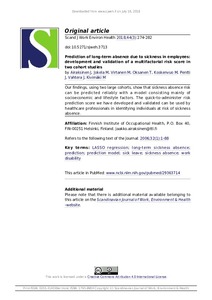Prediction of long-term absence due to sickness in employees: development and validation of a multifactorial risk score in two cohort studies
Airaksinen J; Jokela M; Virtanen M; Oksanen T; Koskenvuo M; Pentti J; Vahtera J; Kivimäki M
https://urn.fi/URN:NBN:fi-fe2021042719250
Tiivistelmä
Objectives This study aimed to develop and validate a risk prediction model for long-term sickness absence.
Methods Survey responses on work-and lifestyle-related questions from 65 775 public-sector employees were linked to sickness absence records to develop a prediction score for medically-certified sickness absence lasting > 9 days and >= 90 days. The score was externally validated using data from an independent population-based cohort of 13 527 employees. For both sickness absence outcomes, a full model including 46 candidate predictors was reduced to a parsimonious model using least-absolute-shrinkage-and-selection-operator (LASSO) regression. Predictive performance of the model was evaluated using C-index and calibration plots.
Results Variance explained in >= 90-day sickness absence by the full model was 12.5%. In the parsimonious model, the predictors included self-rated health (linear and quadratic term), depression, sex, age (linear and quadratic), socioeconomic position, previous sickness absences, number of chronic diseases, smoking, shift work, working night shift, and quadratic terms for body mass index and Jenkins sleep scale. The discriminative ability of the score was good (C-index 0.74 in internal and 0.73 in external validation). Calibration plots confirmed high correspondence between the predicted and observed risk. In > 9-day sickness absence, the full model explained 15.2% of the variance explained, but the C-index of the parsimonious model was poor (<0.65).
Conclusions Individuals' risk of a long-term sickness absence that lasts >= 90 days can be estimated using a brief risk score. The predictive performance of this score is comparable to those for established multifactorial risk algorithms for cardiovascular disease, such as the Framingham risk score.
Kokoelmat
- Rinnakkaistallenteet [27094]
